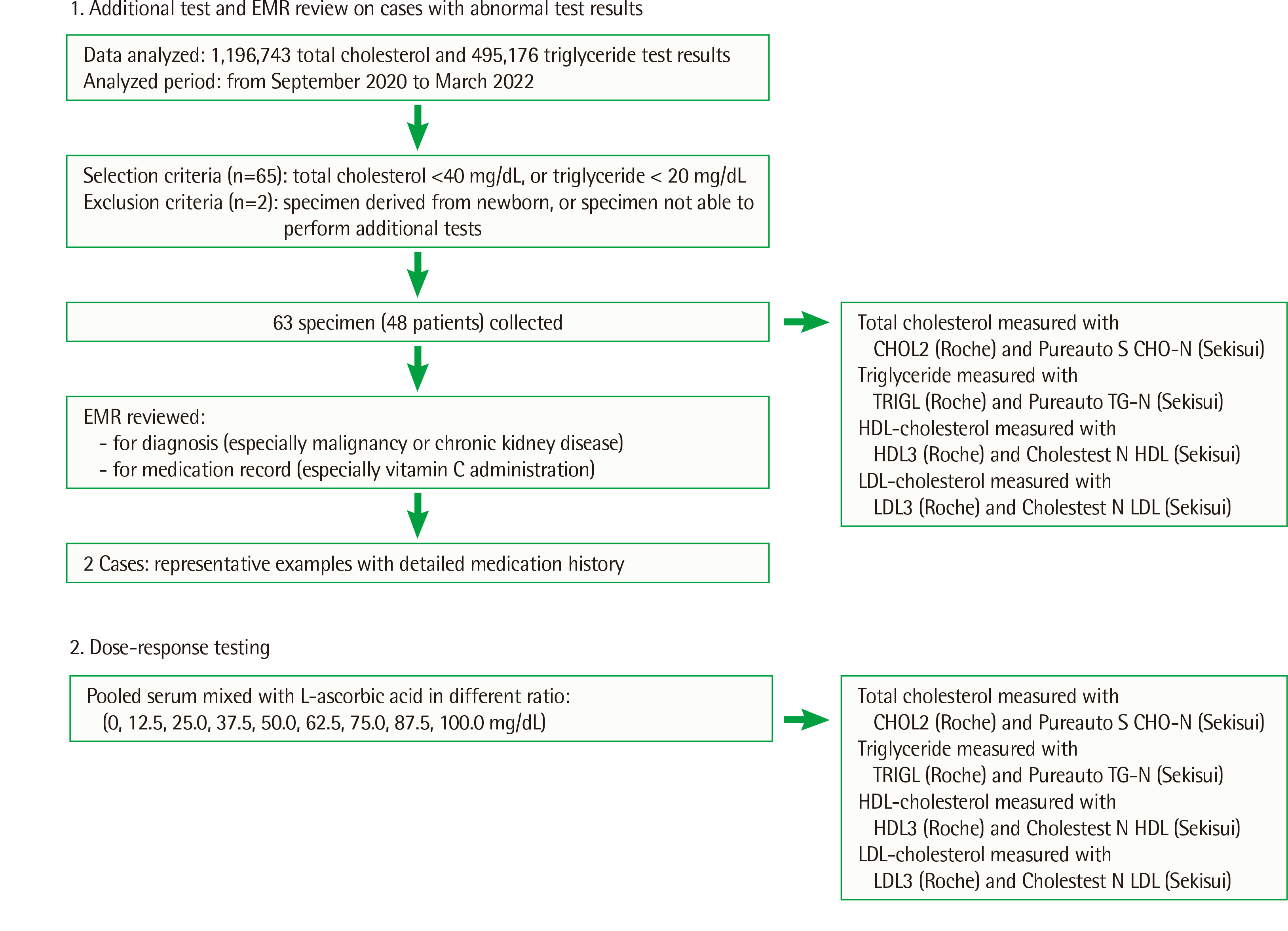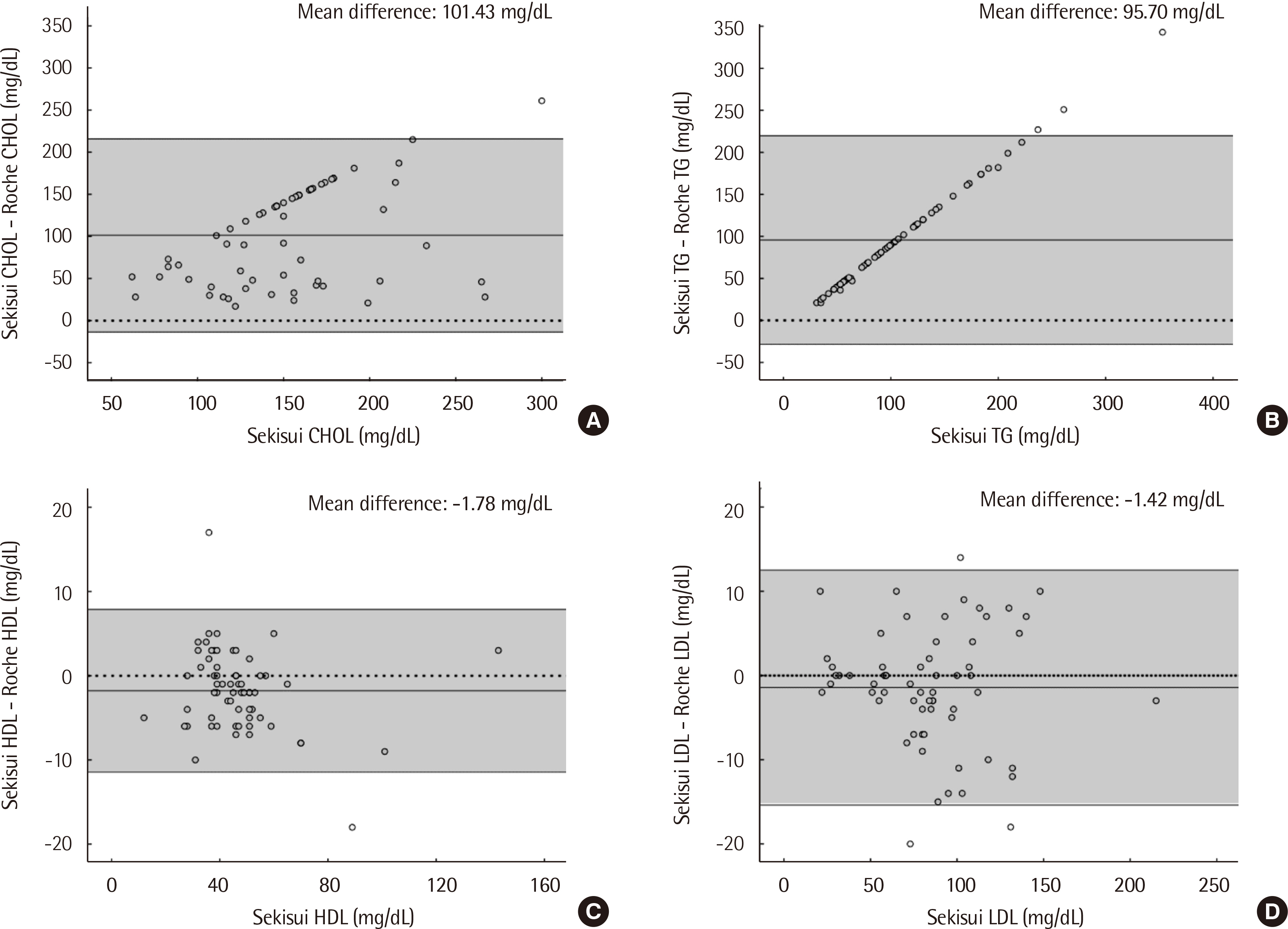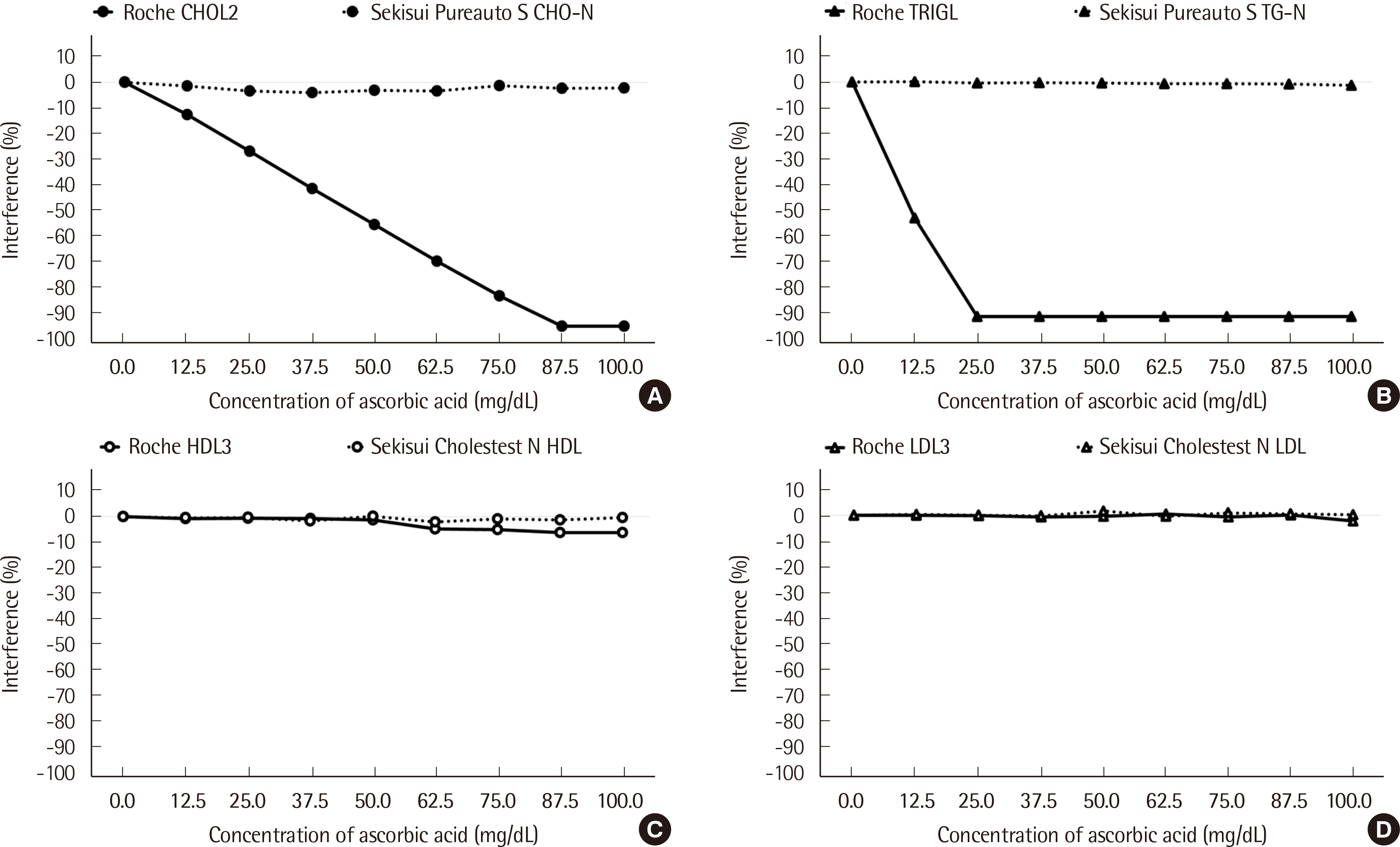Lab Med Online.
2023 Jan;13(1):13-21. 10.47429/lmo.2023.13.1.13.
The negative role of Vitamin C in total cholesterol and triglycerides tests
- Affiliations
-
- 1Department of Laboratory Medicine and Genetics, Samsung Medical Center, Sungkyunkwan University School of Medicine, Seoul, Korea
- 2Department of Laboratory Medicine, Wonkwang University Hospital, Iksan, Korea
- 3Department of Laboratory Medicine, Seoul National University, Bundang Hospital, Seongnam, Korea
- KMID: 2552720
- DOI: http://doi.org/10.47429/lmo.2023.13.1.13
Abstract
- Background
This study aimed to determine the cause of low total cholesterol and triglyceride levels based on the Trinder reaction by reviewing cases of negative interference.
Methods
We analyzed the results of total cholesterol and triglyceride tests performed over 19 months. Sixty-three test results from 48 patients showing abnormally low total cholesterol or triglyceride levels were included. Lipid profile (total cholesterol, triglyceride, HDL-cholesterol, and LDL-cholesterol) was evaluated with Roche Diagnostics (Germany) and Sekisui Medical (Japan) reagents by using Cobas c702 analyzer (Roche). In vitro lipid profile tests were also determined using both above reagents for serum spiked with nine different concentrations of vitamin C.
Results
Total cholesterol and triglyceride levels measured using Roche reagents (without ascorbate oxidase) were significantly lower than those using Sekisui reagents containing ascorbate oxidase respectively. HDL-cholesterol and LDL-cholesterol levels showed no significant difference between the two company reagents. Malignancy was diagnosed in 83% of the patients, and the patients have the possibility of receiving high-dose vitamin C therapy. In addition, 27% of the patients were diagnosed with chronic kidney disease. At the level of 25.0 mg/dL vitamin C to the serum, total cholesterol and triglyceride levels, measured using Roche reagents, reduced by 27% and 95%, respectively, but were rarely reduced when using Sekisui reagents.
Conclusions
When negative interference is suspected in the total cholesterol or triglyceride of patients, the specimens need to be retested with the reagent containing ascorbate oxidase, and the patient’s medical record should be reviewed thoroughly.
Keyword
Figure
Cited by 2 articles
-
음성 간섭을 감소시키도록 개선된 Norudia 당화알부민 시약의 성능평가
Beomki Lee, Sang-Mi Kim, Hyung-Doo Park
Lab Med Online. 2024;14(2):100-105. doi: 10.47429/lmo.2024.14.2.100.Adjustment Formula for Harmonizing Triglyceride Values in the Korea National Health and Nutrition Examination Survey, 2005–2022
Rihwa Choi, Jong Do Seo, Eun-Jung Cho, Woochang Lee, Yeo-Min Yun
Ann Lab Med. 2025;45(3):291-299. doi: 10.3343/alm.2024.0317.
Reference
-
1. Bachorik PS, Ross JW. 1995; National Cholesterol Education Program recommendations for measurement of low-density lipoprotein cholesterol: executive summary. The National Cholesterol Education Program Working Group on Lipoprotein Measurement. Clin Chem. 41:1414–20. DOI: 10.1093/clinchem/41.10.1414. PMID: 7586510.2. Committee of Clinical Practice Guideline of the Korean Society of Lipid, Atherosclerosis. 2018. Korean Guidelines for the Management of Dyslipidemia. 4th ed. Seoul, Korea: The Korean Society of Lipid & Atherosclerosis.3. Trinder P. 1969; Determination of glucose in blood using glucose oxidase with an alternative oxygen acceptor. Ann Clin Biochem. 6:24–8. DOI: 10.1177/000456326900600108.4. Genzen JR, Hunsaker JJ, Nelson LS, Faine BA, Krasowski MD. 2016; N-acetylcysteine interference of Trinder-based assays. Clin Biochem. 49:100–4. DOI: 10.1016/j.clinbiochem.2015.10.005. PMID: 26500003.5. Guo X, Hou La, Cheng X, Zhang T, Yu S, Fang H, et al. 2015; Strong negative interference by calcium dobesilate in sarcosine oxidase assays for serum creatinine involving the trinder reaction. Medicine (Baltimore). 94:e905. DOI: 10.1097/MD.0000000000000905. PMID: 26061311. PMCID: PMC4616468.6. Tarasek D, Gąsowska-Bajger B, Wojtasek H. 2020; Mechanisms of interference of p-diphenols with the Trinder reaction. Bioorg Chem. 97:103692. DOI: 10.1016/j.bioorg.2020.103692. PMID: 32155504.7. Spain MA, Wu AH. 1986; Bilirubin interference with determination of uric acid, cholesterol, and triglycerides in commercial peroxidase-coupled assays, and the effect of ferrocyanide. Clin Chem. 32:518–21. DOI: 10.1093/clinchem/32.3.518. PMID: 3948397.8. Nah H, Yim J, Lee SG, Lim JB, Kim JH. 2016; Ascorbate oxidase minimizes interference by high-concentration ascorbic acid in total cholesterol assays. Ann Lab Med. 36:188–90. DOI: 10.3343/alm.2016.36.2.188. PMID: 26709272. PMCID: PMC4713858.9. Ministry of Health, Welfare of Korea, Korea Centers for Disease Control, Prevention. 2020. 2019 Korea Health Statistics. Seoul, Korea: Ministry of Health and Welfare of Korea.10. Clinical, Laboratory Standards Institute. 2018. Interference testing in clinical chemistry. 3rd ed. CLSI guideline EP07. Wayne, PA: Clinical and Laboratory Standards Institute.11. Yoo DW, Jun KR, Lee JH, Hwang WJ, Lee SM, Kim HH, et al. 2020; False decrease in serum triglyceride and cholesterol due to massive ascorbate in a bowel preparation solution. Clin Chem Lab Med. 59:e121–4. DOI: 10.1515/cclm-2020-0782. PMID: 33001845.12. Zoppi F, Fenili D. 1980; Drug interferences in reactions for detecting hydrogen peroxide by means of peroxidase. Clin Chem. 26:1229–30. DOI: 10.1093/clinchem/26.8.1229. PMID: 6248269.13. White-Stevens RH. 1982; Interference by ascorbic acid in test systems involving peroxidase. I. Reversible indicators and the effects of copper, iron, and mercury. Clin Chem. 28:578–88. DOI: 10.1093/clinchem/28.4.578. PMID: 7074824.14. White-Stevens RH, Stover LR. 1982; Interference by ascorbic acid in test systems involving peroxidase. II. Redox-coupled indicator systems. Clin Chem. 28:589–95. DOI: 10.1093/clinchem/28.4.589. PMID: 7074825.15. Martinello F, da Silva EL. 2006; Ascorbic acid interference in the measurement of serum biochemical parameters: in vivo and in vitro studies. Clin Biochem. 39:396–403. DOI: 10.1016/j.clinbiochem.2005.11.011. PMID: 16403487.16. Cameron E, Pauling L. 1976; Supplemental ascorbate in the supportive treatment of cancer: Prolongation of survival times in terminal human cancer. Proc Natl Acad Sci USA. 73:3685–9. DOI: 10.1073/pnas.73.10.3685. PMID: 1068480. PMCID: PMC431183.17. Creagan ET, Moertel CG, O'Fallon JR, Schutt AJ, O'Connell MJ, Rubin J, et al. 1979; Failure of high-dose vitamin C (ascorbic acid) therapy to benefit patients with advanced cancer: a controlled trial. N Engl J Med. 301:687–90. DOI: 10.1056/NEJM197909273011303. PMID: 384241.18. Ngo B, Van Riper JM, Cantley LC, Yun J. 2019; Targeting cancer vulnerabilities with high-dose vitamin C. Nat Rev Cancer. 19:271–82. DOI: 10.1038/s41568-019-0135-7. PMID: 30967651. PMCID: PMC6526932.19. Böttger F, Vallés-Martí A, Cahn L, Jimenez CR. 2021; High-dose intravenous vitamin C, a promising multi-targeting agent in the treatment of cancer. J Exp Clin Cancer Res. 40:343. DOI: 10.1186/s13046-021-02134-y. PMID: 34717701. PMCID: PMC8557029.20. Ladas EJ, Jacobson JS, Kennedy DD, Teel K, Fleischauer A, Kelly KM. 2004; Antioxidants and cancer therapy: a systematic review. J Clin Oncol. 22:517–28. DOI: 10.1200/JCO.2004.03.086. PMID: 14752075.21. Hongsawong N, Chawprang N, Kittisakmontri K, Vittayananan P, isuwan K Sr, Chartapisak W. 2021; Vitamin C deficiency and impact of vitamin C administration among pediatric patients with advanced chronic kidney disease. Pediatr Nephrol. 36:397–408. DOI: 10.1007/s00467-020-04662-9. PMID: 32683655.22. Deicher R, Hörl WH. 2003; Vitamin C in chronic kidney disease and hemodialysis patients. Kidney Blood Press Res. 26:100–6. DOI: 10.1159/000070991. PMID: 12771534.23. Moshides JS. 1987; Comparison of ascorbic acid interference in HDL-cholesterol estimation by six precipitation methods, with use of a sensitive enzymic cholesterol reagent. Clin Chem. 33:1467–8. DOI: 10.1093/clinchem/33.8.1467a. PMID: 3608171.24. Hubbard RS, Hirany SV, Devaraj S, Martin L, Parupia J, Jialal I. 1998; Evaluation of a rapid homogeneous method for direct measurement of high-density lipoprotein cholesterol. Am J Clin Pathol. 110:495–502. DOI: 10.1093/ajcp/110.4.495. PMID: 9763036.25. Yim J, Cho J, Ahn S, Lee SG, Kim JH. 2017; A practical way to overcome ascorbate interference in total cholesterol and triglyceride measurement by exploiting the autoxidation property of ascorbate. Clin Biochem. 50:350–1. DOI: 10.1016/j.clinbiochem.2016.11.027. PMID: 27914934.
- Full Text Links
- Actions
-
Cited
- CITED
-
- Close
- Share
- Similar articles
-
- Effects of Long Term Administration of Vitamin A on Lipids of Liver Tissue and Serum in Rat
- Associations between Vitamin D and Indicators of Common Chronic Diseases in Korean Adults
- Vitamin D Status and Its Relation with Abdominal Adiposity and Cardiovascular Risk Factors of Korean Adults in Certain Areas
- Influence of Blood Lipids on Global Coagulation Test Results
- Analysis of Plasma Long-Chain Fatty Acids in Hypertensive Patients





